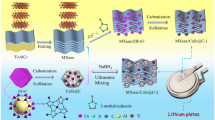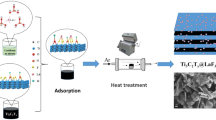Abstract
Despite its high electrical conductivity and large redox-active surface area, the widespread application of Ti3C2Tx MXene was still restricted by its sluggish kinetics with low capacity for lithium-ion storage. In this article, both density functional theory (DFT) calculations and experiments had demonstrated that sulfur decorating provided an alternative to improve the lithium storage performance of Ti3C2Tx, which played a series of roles in enlarging interlayer spacing, accelerating the lithium-ion diffusion as well as improving Li storage capacity. Consequently, the S-decorated Ti3C2Tx delivered a high reversible capacity of 167.8 mA h g−1 after 100 cycles at 0.5 A g−1, excellent rate capability (138.5 mA h g−1 at 1 A g−1 and 121.2 mA h g−1 at 2 A g−1) and robust long-term cycling stability with a reversible capacity of 166.3 mA h g−1 after 400 cycles at 0.5 A g−1. These findings revealed an important new strategy for further design and rational fabrication of MXenes for energy storage applications.
Graphical abstract
The S-Ti3C2Tx material had a large interlayer spacing, which made it had excellent electrochemical performance in lithium battery applications, and the calculated results showed that it only had a diffusion barrier of 0.24eV.









Similar content being viewed by others
References
Dai X, Lei SL, Liu J, Shang ZT et al (2021) Promoting the energy density of lithium-ion capacitor by coupling the pore-size and nitrogen content in capacitive carbon cathode. J Power Sources 498:229912–229921
Chen J, Xu Y, Cao MH et al (2019) A stable 2D nano-columnar sandwich layered phthalocyanine negative electrode for lithium-ion batteries. J Power Sources 426:169–177
Li JW, Yao WL, Zhang FC et al (2021) Porous SnO2 microsphere and its carbon nanotube hybrids: controllable preparation, structures and electrochemical performances as anode materials. Electrochim Acta 308:138532–138542
Yan L, Li D, Yan T et al (2019) Creating sandwich-like Ti3C2/TiO2/rGO as anode materials with high energy and power density for Li-ion hybrid capacitors. ACS Sustain Chem Eng 7:15394–15403
Chang ER, Zhao M, Makaryan T et al (2016) Porous two-dimensional transition metal carbide (MXene) flakes for high-performance Li-ion storage. ChemElectroChem 3:689–693
Khazaei M, Arai M, Sasaki T et al (2013) Intercalation and delamination of layered carbides and carbonitrides. Nat Commun 4:1716–1722
Ma Z, Zhou X, Deng W, Lei D, Liu Z (2018) 3D porous MXene (Ti3C2)/reduced graphene oxide hybrid films for advanced lithium storage. ACS Appl Mater Interfaces 10:3634–3643
Liu A, Liang X, Ren X et al (2016) Recent progress in MXene-Based materials: potential high-performance electrocatalysts. Adv Funct Mater 30:1–22
Li C, Xue X, Qin J et al (2020) Synthesis of nickel hydroxide/delaminated-Ti3C2 MXene nanosheets as promising anode material for high performance lithium ion battery. J Alloys Compd 842:155812
Zhang R, Xue Z, Qin J, Sawangphruk M, Zhang X, Liu R (2020) NiCo-LDH/Ti3C2 MXene hybrid materials for lithium ion battery with high-rate capability and long cycle life. J Energy Chem 50:143–153
Zhang D, Cao J, Zhang X, Insin N, Liu R, Qin J (2020) NiMn layered double hydroxide nanosheets in-situ anchored on Ti3C2 MXene via chemical bonds for superior supercapacitors. ACS Appl Energy Mater 3:5949–5964
Sang X, Xie Y, Lin MW et al (2016) Atomic defects in monolayer titanium carbide (Ti3C2Tx) MXene. ACS Nano 10:9193–9200
Naguib M, Kurtoglu M, Presser V et al (2011) Two-dimensional nanocrystals produced by exfoliation of Ti3AlC2. Adv Mater 23:4248–4253
Zhang Y, Mu Z, Yang C et al (2018) Rational design of MXene/1T-2H MoS2-C nanohybrids for high-performance lithium-sulfur batteries. Adv Funct Mater 28:1707578–1707586
Huang J, Meng R, Zu L et al (2018) Sandwich-like Na0.23TiO2 nanobelt/Ti3C2 MXene composites from a scalable in situ transformation reaction for long-life high-rate lithium/sodium-ion batteries. Nano Energy 46:20–28
Liu Y, He Y, Vargun E, Plachy T, Saha P, Cheng Q (2020) 3D porous Ti3C2 MXene/NiCo-MOF composites for enhanced lithium storage. Nanomaterials 10:695–708
Shen C, Wang L, Zhou A et al (2018) Synthesis and electrochemical properties of two-dimensional RGO/Ti3C2Tx nanocomposites. Nanomaterials 8:80–90
Cao J, Zhang D, Chanajaree R et al (2021) Stabilizing zinc anode via a chelation and desolvation electrolyte additive. Adv Powder Mater 9:100007–100015
Liu Z, Luo X, Qin L, Fang G, Liang S (2021) Progress and prospect of low-temperature zinc metal batteries. Adv Powder Mater 1:100011–100026
Li D, Chen X, Xiang P, Du H, Xiao B (2020) Chalcogenated-Ti3C2X2 MXene (X=O, S, Se and Te) as a high-performance anode material for Li-ion batteries. Appl Surf Sci 501:144221.1–144221.9
Rakhi RB, Ahmed B, Hedhili MN, Anjum DH, Alshareef HN (2015) Effect of postetch annealing gas composition on the structural and electrochemical properties of Ti2CTx MXene electrodes for supercapacitor applications. Chem Mater 27:5314–5323
Zhang S, Ying H, Guo R, Yang WT, Han W (2020) Vapor deposition red phosphorus to prepare nitrogen-doped Ti3C2Tx MXenes composites for lithium-ion batteries. J Phys Chem Lett 10:6446–6454
Luo J, Zheng J, Nai J et al (2019) Atomic sulfur covalently engineered interlayers of Ti3C2 MXene for ultra-fast sodium-ion storage by enhanced pseudocapacitance. Adv Funct Mater 29:1808107–1808116
Luo J, Tao X, Zhang J et al (2016) Sn4+ ion decorated highly conductive Ti3C2 MXene: promising lithium-ion anodes with enhanced volumetric capacity and cyclic performance. ACS Nano 10:2491–2499
Han Q, Zhou YL, Du R et al (2021) Ti3C2Tx with a hydroxyl-rich surface for metal sulfides as high performance electrode materials for sodium/lithium storage. J Mater Chem A 9:14013–14024
Dong YF, Wu ZS, Zheng SH et al (2017) Ti3C2 MXene-derived sodium/potassium titanate nanoribbons for high-performance sodium/potassium ion batteries with enhanced capacities. ACS Nano 11:4792–4800
Halim J, Cook KM, Naguib M, Eklund P et al (2016) X-ray photoelectron spectroscopy of select multi-layered transition metal carbides (MXenes). Appl Surf Sci 362:406–417
Naguib M, Kurtoglu M, Presser V et al (2011) Two-dimensional nanocrystals produced by exfoliation of Ti3AlC2. Adv Mater 23(37):4248–4253
Fleet ME, Harmer SL, Liu X et al (2005) Polarized X-ray absorption spectroscopy and XPS of TiS3: S K- and Ti L-edge XANES and S and Ti 2p XPS. Surf Sci 584:133–145
Naguib M, Come J, Dyatkin B et al (2012) MXene: a promising transition metal carbide anode for lithium-ion batteries. Electrochem Commun 16:61–64
Lu M, Han WJ, Li HJ et al (2019) Tent-pitching-inspired high-valence period 3-cation pre-intercalation excels for anode of 2D titanium carbide (MXene) with high Li storage capacity. Energy Storage Mater 16:163–168
Du F, Tang H, Pan LM et al (2017) Environmental friendly scalable production of colloidal 2D titanium carbonitride MXene with minimized nanosheets restacking for excellent cycle life lithium-ion batteries. Electrochim Acta 235:690–699
Jia L, Li YL, Su LJ et al (2020) TiO2 nanoparticles in situ formed on Ti3C2 nanosheets by a one-step ethanol-thermal method for enhanced reversible lithium-ion storage. ChemistrySelect 5:3124–3129
Wu J, Wang Y, Zhang Y et al (2020) Highly safe and ionothermal synthesis of Ti3C2 MXene with expanded interlayer spacing for enhanced lithium storage. J Energy Chem 47:203–209
Zhao X, Xu H, Hui Z et al (2019) Electrostatically assembling 2D nanosheets of MXene and MOF-derivatives into 3D hollow frameworks for enhanced lithium storage. Small 15:1904255–1904263
Xie X, Zhao M-Q, Anasori B et al (2016) Porous heterostructured MXene/carbon nanotube composite paper with high volumetric capacity for sodium-based energy storage devices. Nano Energy 26:513–523
Xia M, Chen B, Gu F et al (2020) Ti3C2Tx MXene nanosheets as a robust and conductive tight on Si anodes significantly enhance electrochemical lithium storage performance. ACS Nano 14:5111–5120
Tang Q, Zhou Z, Shen P (2012) Are MXenes promising anode materials for li ion batteries? Computational studies on electronic properties and Li storage capability of Ti3C2 and Ti3C2X2 (X = F, OH) monolayer. J Am Chem Soc 134:16909–16916
Er DQ, Li JW, Naguib M, Gogotsi Y, Shenoy VB (2014) Ti3C2 MXene as a high capacity electrode material for metal (Li, Na, K, Ca) ion batteries. ACS Appl Mater Interfaces 6:11173–11179
Xie Y, Naguib M, Mochalin VN et al (2014) Role of surface structure on Li-ion energy storage capacity of two-dimensional Transition-Metal Carbides. J Am Chem Soc 136:6385–6394
Bai LN, Kong LY, Wen J, Ma N, Gao H, Zhang XT (2020) First-principles study of high performance lithium/sodium storage of Ti3C2T2 nanosheets as electrode materials. Chin Phys B 29:398–407
Yi WC, Tang G, Chen X, Yang BC, Liu, XB (2020) qvasp: a flexible toolkit for VASP users in materials simulations. Comput Phys Commun 257:107535–107540
Wang V, Xu N, Liu, JC et al (2021) VASPKIT: a user-friendly interface facilitating high-throughput computing and analysis using VASP code. Comput Phys Commun 267:108033–108051
Acknowledgements
The research was financially supported by National Natural Science Foundation of China (21865012), Education Department Project Fund of Jiangxi Province (GJJ190432), Ganzhou Science and Technology Innovation Talent Program, the Program of Qingjiang Excellent Young Talents, Jiangxi University of Science and Technology.
Author information
Authors and Affiliations
Corresponding author
Ethics declarations
Conflict of interest
The authors declare no competing financial interest.
Additional information
Handling Editor: Mark Bissett.
Publisher's Note
Springer Nature remains neutral with regard to jurisdictional claims in published maps and institutional affiliations.
Supplementary Information
Below is the link to the electronic supplementary material.
10853_2022_6983_MOESM1_ESM.docx
Additional figures including Experimental Section, Computational Methods, possible adsorption sites, DOS and the maximum storage capacity for Li-ion. Supplementary file1 (DOCX 2726 kb)
Rights and permissions
About this article
Cite this article
Yuan, K., Hao, P., Hu, X. et al. Experimental and computational studies on S-decorated Ti3C2 MXene as anode material in Li-ion batteries. J Mater Sci 57, 7001–7011 (2022). https://doi.org/10.1007/s10853-022-06983-6
Received:
Accepted:
Published:
Issue Date:
DOI: https://doi.org/10.1007/s10853-022-06983-6




